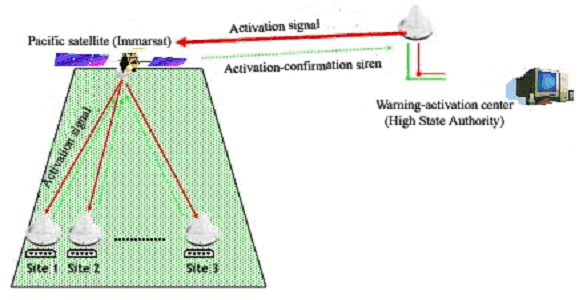SENAT
Report n° 117 (2007-2008) by M. Roland COURTEAU, Senator (for the parliament office for the evaluation of scientific and technological choices) - Appendix to the minutes of the 7 December 2007 session
Disponible au format Acrobat (21 Moctets)
(3) A warning system best suited to the characteristics of French Polynesia
As has been pointed out several times, a warning system is only effective if it affects the population and if the population reacts accordingly. However, the distinctive characteristics of French Polynesia make setting up a warning system difficult.
Firstly, this territory has a surface area of 4,200 km² scattered over 5 million km² of ocean, with 256,000 inhabitants divided between dozens of islands. While it is true that 80% of the population is concentrated on Tahiti and Moorea, 8,000 persons people the 5 Marquesas Islands and 5,000 inhabitants live on the 44 islands of the Tuamotus. Therefore, the warning must quickly touch a widely-scattered population.
Secondly, there are many interlocutors. Civil security is shared between the French government, responsible for the coordination of assistance efforts, and the Assembly of French Polynesia, responsible for tsunami prevention. In addition, the districts lack their own resources and the mayors, who are meant to take over in the event of a warning being issued, are not always reachable or even present in their districts, residing as they often do in Tahiti.
Taking into account these constraints, it was decided to create a centralized, automatic alert system.
By the end of the year, 144 sirens will have been installed in French Polynesia. Both the High State Authoriy and local authorities will be able to set off these sirens. So as not to be dependent on the local or international telephone or Internet networks 26 ( * ) , each siren may be activated via the Inmarsat mini-C satellite network.
|
The Inmarsat network The Inmarsat network is the first global satellite network for both fixed and mobile terminals. It is used by all of the world's ships to transmit distress and emergency signals, as well as for commercial communications. For the Pacific zone, it is made up of a geostationary satellite and two backup satellites. If need be, Inmarsat can transfer from the satellite in use to one of the two backup satellites without having to reconfigure or repoint the Inmarsat-C terminals. This operation is therefore transparent for network users and practically instantaneous. In addition, the emission and reception of the fixed or mobile terminals are not disturbed by meteorological events, such as cyclones. Finally, the Inmarsat-C terminals' incorporated antennas require no pointing; they enjoy a vertical reception of 360° and a below-horizontal reception of up to 5°. |
The sirens can be set off individually or in groups (an island, an archipelago or all sirens in French Polynesia). The sirens can be activated within 2 minutes by sending a message, with the confirmation message arriving within 4 minutes (see diagram below).
The manual activation process

Source: Assystem
Furthermore, the local authorities have portable satellite telephones (also Inmarsat), allowing them to communicate with the services of the High State Authority even in the event of the local telephone lines being down.
The civil protection services have also passed an agreement with Réseau France Outremer (RFO; "French Overseas Network"): in the event of a tsunami warning, a message is broadcast on television.
While the Assembly of French Polynesia is theoretically responsible for tsunami prevention, the High State Authority is also involved. During your rapporteur's visit to Tahiti, an information brochure entitled "tsunami warnings in French Polynesia" had just been published. Finally, in the Marquesas and Austral Islands, full-scale training exercises are organized, along with the evacuation and transfer of the population.
* 26 Experience has shown that as soon as a disaster is announced, the telephone network is immediately saturated. In addition, Papeete's "Postal and Telecommunications Service" is located on the shoreline: it would be put out of service - and the area's telephone communications would be interrupted - by 1.5 metre or higher waves.







